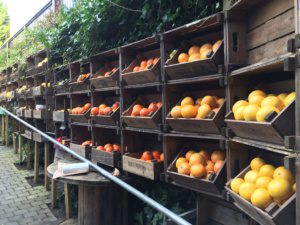By: MJ + PJ
STAGE ONE: Car Based in North America
Knowing that we will be on the road for a while presents a few routine repeating food challenges:
- We need to have food, but not so much that it affects space in the car.
- We need to keep some things cold for up to 48hrs.
- We want a handful of reliable and simple main recipes that are tolerable and repeatable.
- We want breakfasts and snacks that fill nutritional needs and craving needs.
- We will mostly be camp stove cooking, not campfire cooking.
Passing food stores/sources on a regular basis while driving is comforting but we don’t want to be spending time every day walking and decision-making down aisles of goods. This sounds like a great shopping challenge: how fast can we get in and out of a grocery store, buying only 10 to 15 items?
Packaging at this point is an important factor for one main reason: bears. Most national parks we will visit in North America have some sort of bear population. We will have our large bear canister but also a styrofoam cold box which we have found very thermally efficient but not very secure. This works fine for car camping, but if we head into the backcountry that cold option is excluded.
We have backcountry camped so our utensil and tools are already sized and styled for that: multi fuel camp stove, titanium pots, origami dinnerware, multi feature cutlery and utensils. Our cast iron skillet is the exception. No one will carry that in a backpack!
The ‘reliable and simple recipes challenge’ currently has this short list, flavored generously with optimism:
- Mashed potatoes, gravy, stuffing and minced (ground) meat.
- Tortilla soup
- Any pasta, with sauce and canned chicken
- Tacos!
- Loaded potatoes
- Gnocchi, broccoli and nuts
- Upside down Shepard’s pie
- Chicken and bean burritos with salsa
- Sweet potato, Italian sausage and diced tomatoes stew
- Camp quiche
One thing we have noticed about camping recipes is that there are a million to sort through, and hence it is best to stick with what you have already tried in your kitchen and for which you don’t have to buy special or numerous ingredients. Having a flexible recipe is also very useful.
STAGE TWO: Backpack Based
In contrast to STAGE ONE, this is more a case of packing diversely usable, nutritionally dense, compact (preferably dehydrated), and limited preparation food items that do not need to be kept cold. We had a valuable experience on our honeymoon: although a 24 pack of PowerBars fit 3/4 of these criteria, it failed on the fourth – PowerBars are not diversely useable!
With that in mind, this is the projected list of backpack items we intend to pack, appreciating the constraints that present in finding these foods locally, food packaging options, crossing borders, and declaring food items.
- Quinoa, orzo, cous cous, lentils, instant potatoes
- Tuna or chicken in flat packs or cans
- Dense cereals like muesli or granola
- Powdered milk, instant coffee
- Dried fruits, nuts, chocolate
- Tortillas or heavy breads
- Spices, spreads, broth cubes
- Flavoring packets (ranch, taco, Italian, gravy, etc)
The other essential ingredient here is water. This is not something you want to lug around by the gallon in your pack unless you are in a desert. Add in a water filter system and UV probe and iodine tabs to solve and provide backup for water treatment.
You don’t have to look far to find a good general backpacking list with insightful reasoning, like at REI.

